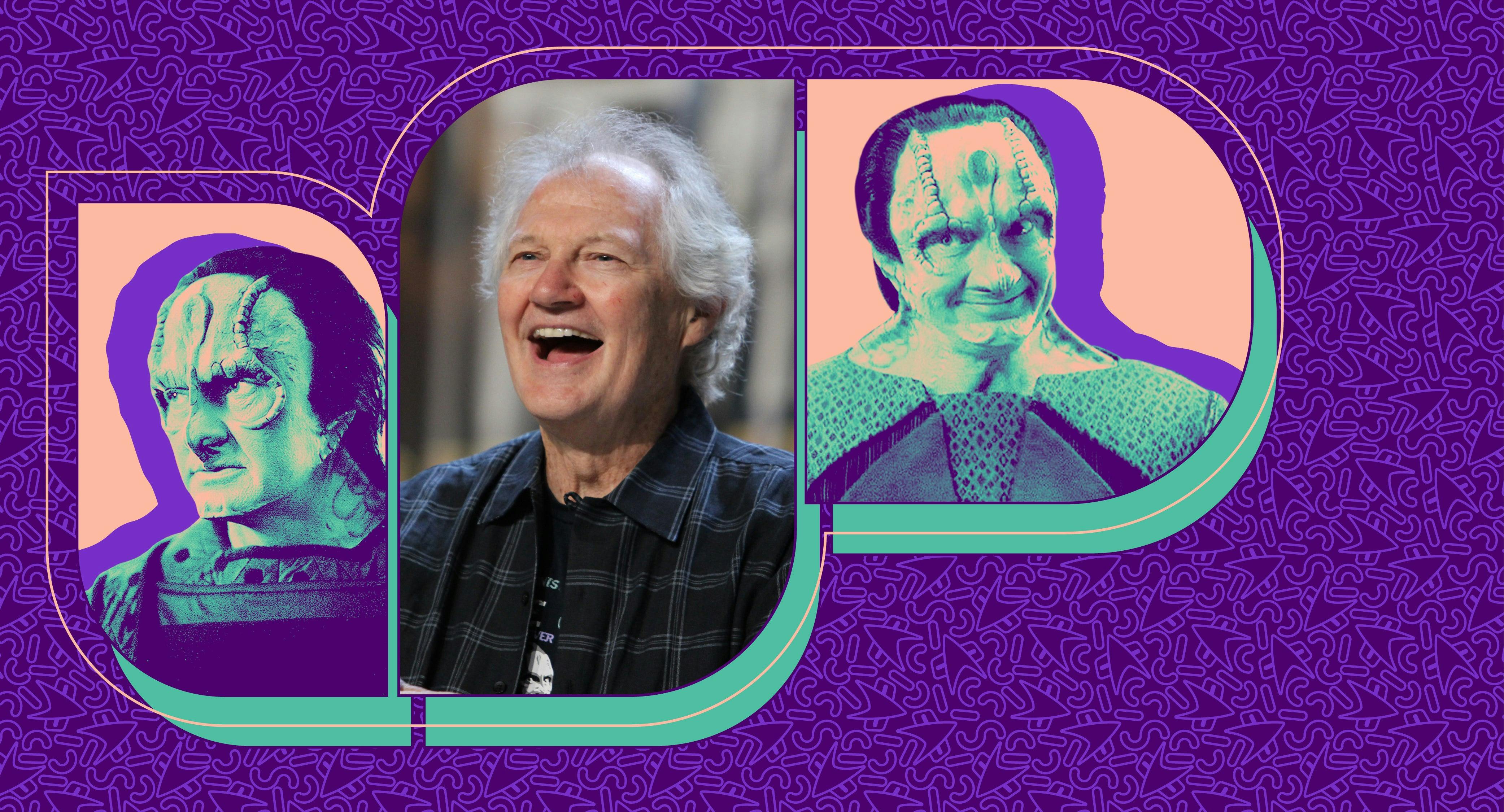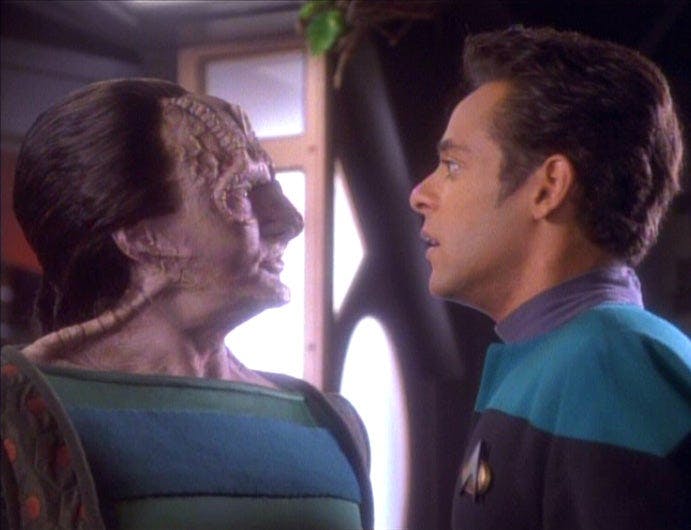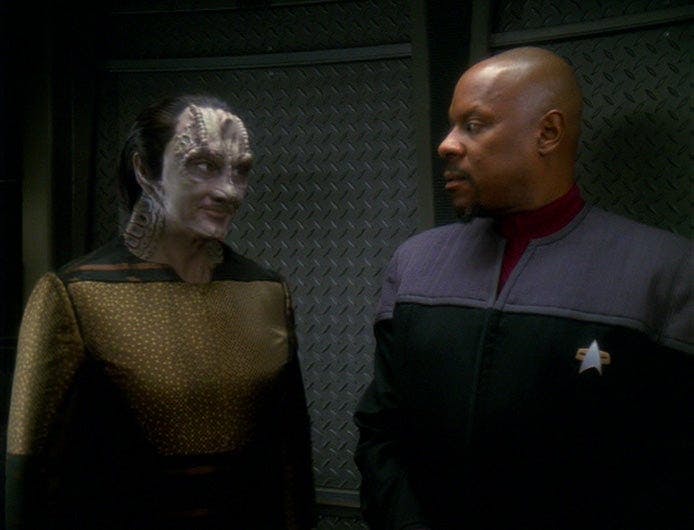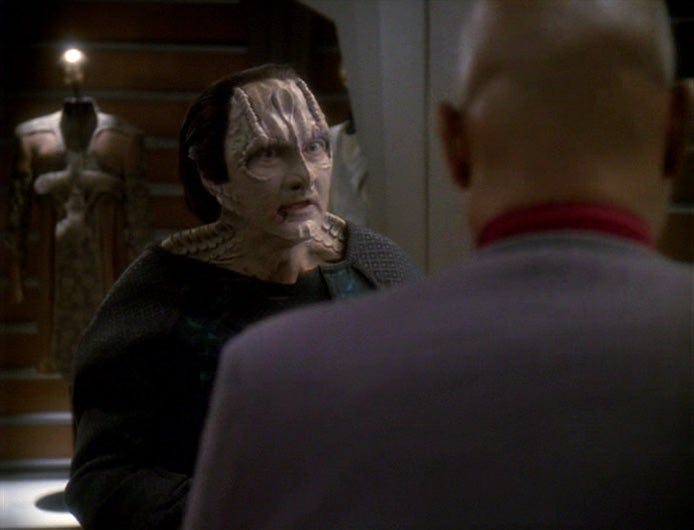Published Apr 15, 2022
Andrew Robinson Reflects On In the Pale Moonlight
The actor shares Garak's secrets

StarTrek.com
In addition to its astounding series regulars, Star Trek: Deep Space Nine boasted a wealth of memorable recurring characters. Chief among those Garak, the outcast Cardassian spy who served as the station’s resident tailor while still dabbling in his fair share of interstellar affairs. Portrayed by veteran actor Andrew Robinson, Garak quickly became a fan-favorite among the Star Trek faithful, both for his mysterious past and his bond with Doctor Julian Bashir. The ‘simple tailor’ also went on to play a pivotal role in “In the Pale Moonlight,” a classic DS9 installment that is often ranked as one of the best episodes in the entire franchise.
StarTrek.com caught up with Robinson to chat about Garak’s origins, the back-and-forth rapport with Doctor Bashir, filming “In the Pale Moonlight,” and much more.
StarTrek.com: We’re going to start by going back to the very beginning. Do you recall how you perceived Garak as a character when you first read for the role?
Andrew Robinson: Well, there was no backstory. I was given no information, not even about what Cardassians are. I got a script that said there’s this guy who’s kind of mysterious, he’s called a Cardassian, and he’s on the station. That pretty much was it. I was not a Star Trek person, I hadn’t watched The Original Series or The Next Generation.
I was told there were a couple of Cardassians on The Next Generation, so I checked them out — it was David Warner and Marc Alaimo. I loved the look of them, and the two were sort of severe and militaristic. On the page, Garak was not. Garak was a very mysterious character, which is what attracted me, of course.

StarTrek.com
Extrapolating what I could from the script, I knew Doctor Bashir was fascinated with him, as the rumor was that Garak was a spy. Garak’s situation was interesting to me, because he was a highly suspect presence due to Bajor’s history with Cardassia.
Essentially, I had to make up a story for myself [laughs]. That’s when I started writing about Garak, because I had to make up his backstory and create this world called Cardassia. I started there, and I assumed that he was a spy. Even though there was no mention of the Obsidian Order at that point, I knew that he was not what he seemed to be. I had to make up a history for him that I could hold on to while I played this very affable, very cultured, friendly, and curious man.
Were any elements of the backstory that you created ever emerge in later episodes?
AR: No, no. Where it did come out was in a book I ended up writing about Garak, called A Stitch in Time. I was very proud of that book, because it turned out that I was so in sync with the character that a lot of the stuff I wrote for myself from my own imagination ended up being accurate. It was in the direction that DS9’s writers were going with the character. I’ve never had another experience like that in my acting career. Playing Garak was unique and life-changing in so many ways.
The incredible chemistry your character had with Alexander Siddig’s Doctor Bashir is still evident to this day, as those who’ve seen you in his Sid City virtual chats can attest. In what ways, if any, is your real life friendship similar to the one seen on-screen?
AR: Well, it really isn’t. Garak was a mentor, the voice of experience. In a sense, he was indirectly mentoring Bashir and giving the doctor an education about how things work. Whereas, with Sid and I, Sid is an incredibly bright man. I learn as much from him as he does from me, if anything. It’s a friendship of the heart. He’s a beautiful guy, and the two of us really do enjoy each others’ company.
The other thing is, I think part of my friendship with Sid relies upon the fact that it was because of him that I got the job. They hired me for one episode, and if there had been no chemistry exhibited between us, it wouldn’t have gone any farther. They were looking for a storyline, for a relationship for Doctor Bashir in the series. When they saw that we had a really wonderful, sort of oddball, but kind of classic relationship between mentor and mentee, they sort of picked it up from there and went forward.
There are also quite a few fans who see Garak and Bashir’s bond as extending beyond mere friendship.
AR: [laughs] I know! The fan-fiction is hot!
Was this something you were conscious of while the series was in production?
AR: No, because it was like this thing that gradually grew. Maybe a few years into the show, when I started going to conventions, that’s when I realized that there was the whole thing that was going on.

StarTrek.com
Another pairing that people regularly express appreciation for is your collaboration with Avery Brooks in the episode, “In The Pale Moonlight.” How excited were you to get to play the proverbial devil on Captain Sisko’s shoulder?
AR: Well, that episode was so brave, in every sense of the word. I have such admiration and respect for Avery, and any time I got a chance to play with him, it was a pleasure. He’s a presence. Then, to have this story, which is a classic case of realpolitik, in terms of how things work in the world. The whole situation that’s going on with Russia and Ukraine right now is out of that area- using deception and playing politics in a way that most people aren’t aware that their lives are being changed by the decisions a few people are making.
Now, of course, [Donald] Trump and the Republicans are claiming that [President] Biden is being played by [Russian President] Putin. They’re using this dreadful, sad, tragic, and evil act that’s happening as political maneuvering. All of that stuff comes up in “In the Pale Moonlight.” When Sisko punches Garak in the face, Garak doesn’t come back with a counterpunch. Garak comes back and essentially says, What did you expect? Why do you think you involved me in the first place? You knew what I was going to do. It’s not up to your ethical standards, but you needed me to do it.
Garak was glad to help Sisko find a way to hurt the Dominion, but do you think he took a special delight in seeing such an honorable Starfleet officer willingly dive into the realm of espionage?
AR: Yes, absolutely. The way Europeans and other countries take delight when they’re being lectured by Americans about how the world should go and so forth, and then we step in shit [laughs].
In many ways, the moral ambiguity present in “In The Pale Moonlight” mirrored Garak’s own nebulous principles. Do you believe this is why fans continue to be drawn to both the character and the episode?
AR: Oh, yeah. I think you’re right. Garak will rarely show his hand, so he’s got a secret and is operating on a whole other level from other people. As someone who watches shows, I love those characters who exist in shadows and aren’t black or white, who are in the gray, shaded areas. Even as a kid, I loved film noir for that very reason.

StarTrek.com
Was your appreciation for that style of character translated into your performance?
AR: Absolutely, because I understood it. My very first film was Dirty Harry, and there was no ambiguity about the psychopathic killer I played. Although I loved doing that film, people kept on hiring me for that kind of role and I got really tired of it. At one point, I just stopped doing it, because there was no subtlety or subtext. Shortly after I made that decision, I got the role of Garak. It was like a lifesaver had just been thrown my way. It was the kind of role I love watching- the mystery, the dubious ethics, and the question of whether he’s good or bad.
Those questions actually become irrelevant, because he’s not good or bad. He’s an every man. All of us have our secrets and sometimes have challenges to our ethical and moral lives. In that way, he’s very human. He’s not a brave, heroic figure like Captain Kirk. Nor was he one of the bad monsters on a planet that the original cast or The Next Generation cast would visit weekly. Garak was something else.
I’m speaking of the whole show here. Deep Space Nine evolved, but not everybody liked that it wasn’t a space ship doing one night stands on various planets, defeating bad guys, and solving terrible problems. This was a space station with a lot of complicated types of people there- often the problems didn’t get solved, and you weren’t quite sure about who was good or bad.
As much as I loved Deep Space Nine when it originally aired, it seems that the age of streaming has finally brought the series the recognition and appreciation it deserves.
AR: You’re right, because it’s a quality show that still holds up. We always referred to ourselves as the stepchild of the franchise. The Original Series was sacrosanct and The Next Generation was much more popular than we were. Some of the bigwigs at the studio saw [DS9] was doing just well enough to keep it on, but I think there was a lot of energy that wanted to cancel the show. You’ll notice that we overlapped two shows. They started us as Next Gen was finishing up and then brought in Voyager before we were over. Just when we were establishing our own identity [laughs]. The fact that we survived and did as well as we did is a tribute to Ira [Steven Behr], the writers, and the tremendous cast.
Speaking of the cast, Sisko’s confrontation with Garak at the end of “In the Pale Moonlight” was very intense. Are there any memories from preparing for the scene or filming it with Avery that stand out to you?
AR: See, the only thing I remember about working with Avery was that I was working with a big-time professional. I’ve done a lot of- let’s put it this way, ‘mediocre stuff’ [laughs]. Especially what I did in the 70s. So, to have a script like “In the Pale Moonlight” alongside a superb actor like Avery, it was like doing theatre. It was a major piece of writing. Sisko, being a smart man who was caught in a bind and had to do something, went to the one person who would help him solve the situation. Even though he had to hold his nose when he did it.
On a lighter note, you recently celebrated your 80th birthday. As a gift, two fans from Sid City — Elmie K-E/almaasi and Amy Gochnour — along with Sid City's owner Mel rallied your fans to raise over $4,000 for Save The Children, one of your favorite causes. How did that generous outpouring make you feel?
AR: It overwhelmed me. It’s everything that is good and beautiful about Star Trek fandom. These people are amazing. It’s not just this- over the years, I’ve raised a lot of money for Save the Children. René [Auberjonois], God bless his soul, raised an enormous amount of money for Doctors Without Borders. So many others from the show have done the same thing. We loaned our names, but it was the fans who stepped forward. A gesture like that represents everything that is right and good with this world. It just blew my mind. I wasn’t surprised, but I was blown away.
This interview has been edited and condensed.
Jay Stobie (he/him) is a freelance writer and consultant who has contributed articles to StarTrek.com, Star Trek Explorer, and Star Trek Magazine, as well as to Star Wars Insider and StarWars.com. Jay serves as a BoldlyGo Campaign Ambassador for The Roddenberry Foundation. Jay can be found on Twitter and Instagram at @StobiesGalaxy.

